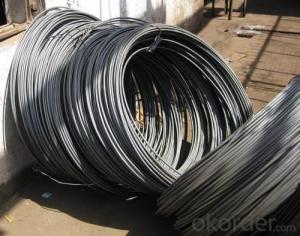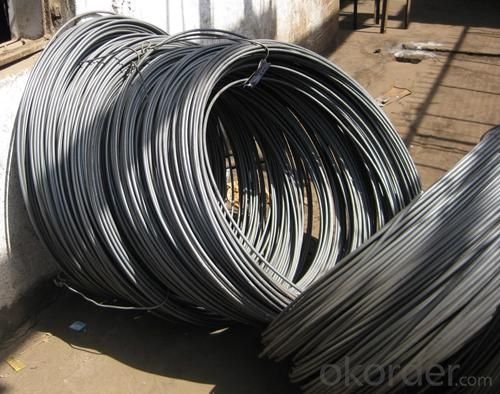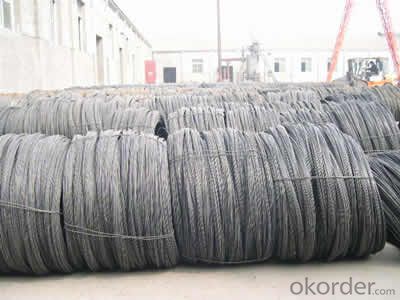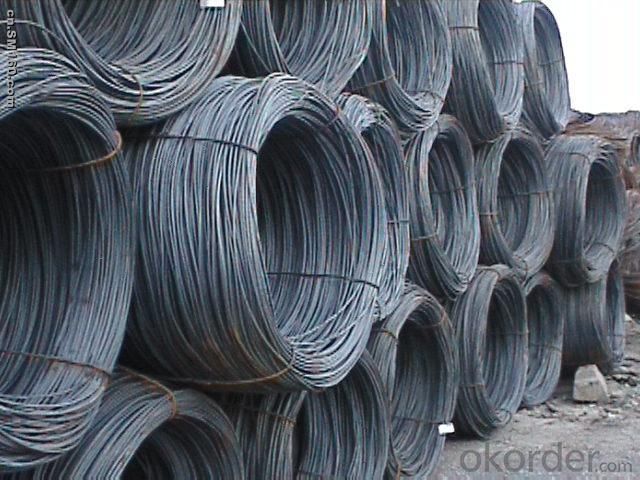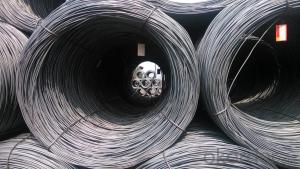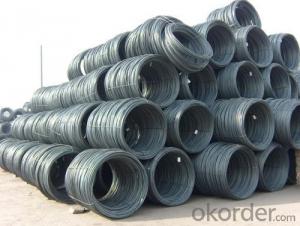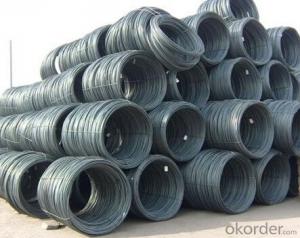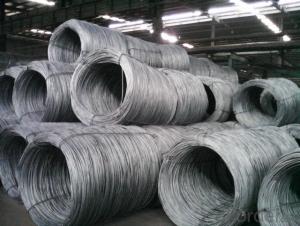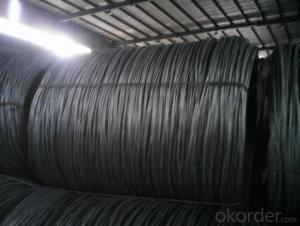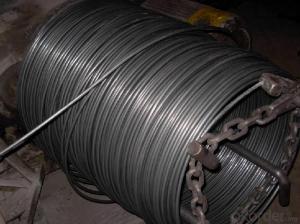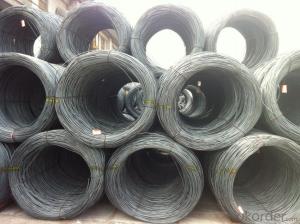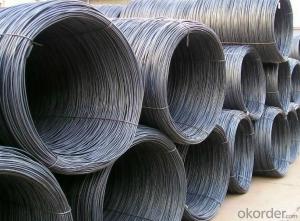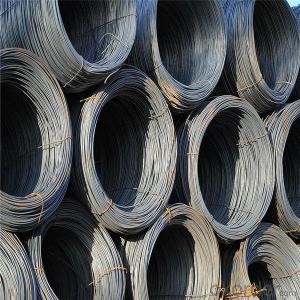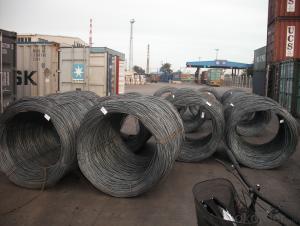Hot Rolled Carbon Steel Wire Rod 12mm with High Quality
- Loading Port:
- China Main Port
- Payment Terms:
- TT or LC
- Min Order Qty:
- 25 m.t.
- Supply Capability:
- 20000 m.t./month
OKorder Service Pledge
OKorder Financial Service
You Might Also Like
Product Description:
OKorder is offering Hot Rolled Carbon Steel Wire Rod 12mm with High Quality at great prices with worldwide shipping. Our supplier is a world-class manufacturer of steel, with our products utilized the world over. OKorder annually supplies products to European, North American and Asian markets. We provide quotations within 24 hours of receiving an inquiry and guarantee competitive prices.
Product Applications:
Hot Rolled Carbon Steel Wire Rod 12mm with High Quality is widely used in construction and manufacturing. Carbon steel wire rod is mainly used for reinforcement of reinforced concrete and welded structure or reprocessed (roberts , nail, etc.) materials, especially used to produce wire drawing, welding electrode, nails, spring, electronic, precise machinery parts and so on.
Product Advantages:
OKorder's Hot Rolled Carbon Steel Wire Rod 12mm with High Quality are durable, strong.
Main Product Features:
· Premium quality
· Prompt delivery & seaworthy packing (30 days after receiving deposit)
· Can be recycled and reused
· Mill test certification
· Professional Service
· Competitive pricing
Product Specifications:
Manufacture: Hot rolled
Grade: SAE1006 SAE1008 SAE1010 SAE1012 SAE1016 SAE1018
Certificates: ISO, SGS, BV, CIQ
Weight per Coil:2-2.05tons
Packaging: Export packing, packed by coil
FAQ:
Q1: Why buy Materials & Equipment from OKorder.com?
A1: All products offered byOKorder.com are carefully selected from China's most reliable manufacturing enterprises. Through its ISO certifications, OKorder.com adheres to the highest standards and a commitment to supply chain safety and customer satisfaction.
Q2: How do we guarantee the quality of our products?
A2: We have established an advanced quality management system which conducts strict quality tests at every step, from raw materials to the final product. At the same time, we provide extensive follow-up service assurances as required.
Q3: How soon can we receive the product after purchase?
A3: Within three days of placing an order, we will begin production. The specific shipping date is dependent upon international and government factors, but is typically 7 to 10 workdays.
Q4: What is the diameter tolerance?
A4: Around +/-0.03mm
Images:
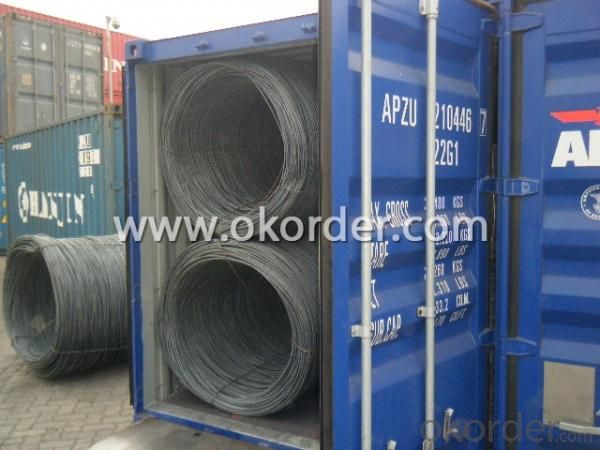
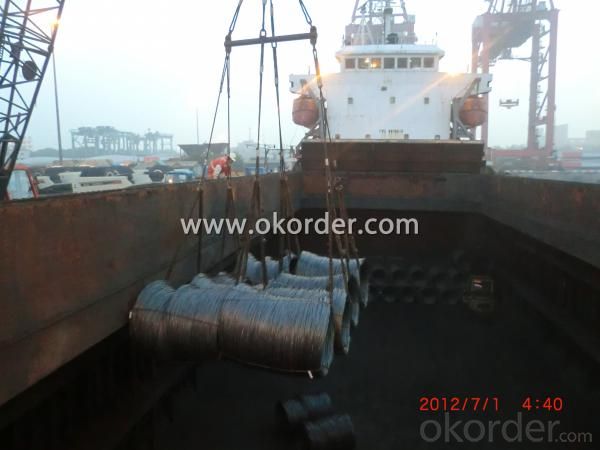
- Q: What are the different surface coating materials used for steel wire rod?
- Some of the different surface coating materials used for steel wire rod are zinc, copper, nickel, and epoxy. These coatings provide various benefits such as corrosion resistance, improved appearance, and enhanced durability.
- Q: How is steel wire rod used in the manufacturing of wire forms for pet enclosures?
- Steel wire rod is indispensable in the production of wire forms for pet enclosures. Typically crafted from high carbon steel, this type of rod provides exceptional strength and durability. To manufacture wire forms for pet enclosures, the steel wire rod undergoes a series of machine processes that stretch and shape it into the desired thickness and length. This procedure, known as drawing, guarantees uniformity and defect-free wire. Once prepared, the wire is then bent and molded into various shapes and sizes to create the wire forms needed for pet enclosures. These wire forms can consist of panels, gates, and frames used in constructing the enclosures. The utilization of steel wire rod in the production of wire forms for pet enclosures offers numerous advantages. Firstly, steel is an incredibly durable material capable of withstanding the wear and tear associated with pet activities. It is also resistant to rust and corrosion, ensuring the wire forms remain in optimal condition despite exposure to various weather conditions. Furthermore, steel wire rod provides the necessary strength and stability required to securely confine pets within the enclosures. This is vital for ensuring the safety and security of the animals. The rigid nature of the steel wire prevents pets from breaking or bending the wire forms, effectively keeping them contained and protected. Moreover, the versatility of steel wire rod allows for customization and flexibility in designing wire forms. Manufacturers can create wire forms in a variety of shapes, sizes, and configurations to cater to the specific needs of pet owners and their pets. In conclusion, steel wire rod plays a crucial role in manufacturing wire forms for pet enclosures. Its strength, durability, and versatility make it an ideal material for producing secure and long-lasting enclosures for pets.
- Q: What are the common welding techniques for steel wire rod?
- Different welding techniques are used for steel wire rods depending on the specific application and desired outcome. Some commonly used techniques include: 1. Gas Metal Arc Welding (GMAW), also known as MIG welding, utilizes a consumable wire electrode and shielding gas to create a weld. GMAW is popular for its versatility, ease of use, and ability to produce high-quality welds when working with steel wire rods. 2. Gas Tungsten Arc Welding (GTAW), also known as TIG welding, involves a non-consumable tungsten electrode and shielding gas to create a weld. GTAW is often employed for precision welding applications that require precise control and a visually appealing weld. 3. Flux-Cored Arc Welding (FCAW) uses a tubular wire electrode with a flux-filled core. The flux serves as a shielding gas and aids in removing impurities from the weld zone. FCAW is suitable for welding steel wire rods outdoors or in windy environments where the shielding gas of GMAW or GTAW may be compromised. 4. Shielded Metal Arc Welding (SMAW), also known as stick welding, employs a consumable electrode coated in flux. The flux generates a shielding gas and assists in removing impurities from the weld zone. SMAW is a versatile and portable welding technique commonly used for steel wire rods in various applications. 5. Resistance Welding involves passing an electric current through the steel wire rods to create resistance and generate heat, fusing the materials together. Resistance welding is commonly utilized for high-speed production welding of steel wire rods, such as in the manufacturing of wire mesh or fences. It is crucial to select the appropriate welding technique based on factors such as the type of steel wire rod, desired weld strength and quality, welding environment, and available equipment and resources.
- Q: What are the common applications of stainless steel wire rod?
- Some common applications of stainless steel wire rod include wire mesh for filters and screens, electrical conductors, reinforcement in concrete structures, wire rope for lifting and rigging, and various mechanical components in industries such as automotive, aerospace, and construction.
- Q: How is steel wire rod transported from the manufacturing plant to the customer?
- Steel wire rods are typically transported from the manufacturing plant to the customer through various modes of transportation, depending on the distance and requirements. The transportation process involves several stages to ensure the safe delivery of the product. Firstly, steel wire rods are usually packaged in coils or bundles to facilitate handling and transportation. These coils or bundles are loaded onto trucks or railway wagons at the manufacturing plant. Trucks are commonly used for shorter distances, while railways are preferred for longer distances due to their larger carrying capacity. For international shipments, steel wire rods are often transported via cargo ships. These ships are equipped with specialized containers or cargo holds to accommodate the coils or bundles securely. The steel wire rods are carefully loaded and secured to prevent any movement during transit. Additionally, cargo ships provide protection against external factors such as weather conditions and potential damage. During transportation, the steel wire rods may undergo customs clearance procedures, especially for international shipments, to ensure compliance with import regulations and documentation requirements. This process can involve inspections, verification of documentation, and payment of any applicable duties or taxes. Upon reaching the destination port or terminal, the steel wire rods are unloaded from the cargo ship and transferred to trucks or trains for further transportation to the customer's location. Depending on the specific requirements, the coils or bundles may be stored temporarily in warehouses or distribution centers before final delivery to the customer. Throughout the entire transportation process, it is crucial to handle the steel wire rods with care to prevent any damage or deformation. Proper securing and handling techniques are employed to ensure the integrity of the product, as any damage can affect its quality and usability. In summary, steel wire rods are transported from the manufacturing plant to the customer through trucks, railways, and cargo ships, depending on the distance and requirements. The coils or bundles are carefully loaded, secured, and transported to ensure the safe delivery of the product.
- Q: What are the different packaging materials used for steel wire rod?
- The different packaging materials used for steel wire rod include wooden pallets, steel frames, steel strapping, and plastic wrapping.
- Q: How is the ductility of steel wire rod evaluated?
- The ductility of steel wire rod is typically evaluated by conducting a tensile test, where a sample of the wire rod is subjected to an increasing load until it eventually breaks. The extent to which the wire rod can be stretched and elongated before fracture provides an indication of its ductility.
- Q: How is steel wire rod used in the production of reinforcement bars?
- Steel wire rod is commonly used in the production of reinforcement bars through a process called cold drawing. The wire rod is first thermomechanically treated to enhance its strength and ductility. It is then cold drawn, which involves pulling the rod through a series of dies to reduce its diameter and increase its length. This cold drawing process imparts high tensile strength and improved surface finish to the wire rod, making it suitable for use in reinforcement bars. The drawn wire rod is further cut into desired lengths and embedded within concrete structures to provide additional strength and stability, improving the overall structural integrity of the reinforced concrete.
- Q: What are the different types of steel wire rod coatings used for electrical conductivity?
- Various types of coatings are used for electrical conductivity in steel wire rods, each with their own distinct characteristics and advantages. Copper is a commonly used coating for electrical conductivity. It possesses excellent electrical conductivity properties, making it an ideal choice for applications that require high electrical performance. Copper coatings can be applied using methods such as electroplating or hot-dipping, ensuring a uniform and durable coating on the steel wire rod. Silver is another coating used for electrical conductivity. It is known for its exceptional electrical conductivity, surpassing even that of copper. It is often utilized in applications that demand the highest level of electrical performance, such as high-frequency cables or precision electronic components. Silver coatings can be applied through electroplating or electroless plating processes, resulting in a thin and highly conductive layer on the steel wire rod. Zinc, although it may not possess the same level of conductivity as copper or silver, is also a commonly used coating for electrical conductivity. Zinc coatings are frequently employed for corrosion protection in electrical applications, as they create a sacrificial layer that prevents the underlying steel wire rod from corroding. Additionally, zinc coatings can enhance the electrical conductivity of the steel wire rod to some extent. Tin coatings are utilized for electrical conductivity as well. Tin is known for its low electrical resistance and good corrosion resistance properties. Tin coatings can be applied through electroplating or hot-dipping processes, resulting in a reliable and conductive layer on the steel wire rod. There are also specialized coatings, such as nickel or gold, that can be used for specific applications requiring unique electrical conductivity properties. Nickel coatings offer good electrical conductivity and corrosion resistance, making them suitable for various electrical and electronic applications. Gold coatings, on the other hand, are highly conductive and provide excellent corrosion resistance, making them ideal for high-end electronic components or connectors. In conclusion, the coatings used for electrical conductivity in steel wire rods encompass copper, silver, zinc, tin, nickel, and gold. Each of these coatings offers specific advantages and is selected based on desired electrical performance, corrosion resistance, and application requirements.
- Q: How is the surface quality of steel wire rod evaluated?
- Various methods and criteria are utilized to assess the surface quality of steel wire rod, ensuring its appropriateness for diverse applications. Among these methods, visual inspection stands as a common approach, wherein trained inspectors visually scrutinize the wire rod's surface for any flaws or irregularities. This encompasses the examination of surface cracks, pits, spots, or any other observable imperfections. In addition to visual inspection, non-destructive testing techniques serve as viable means to evaluate surface quality. One such technique is magnetic particle inspection, which entails the application of a magnetic field to the wire rod, along with the administration of fine iron particles onto the surface. Any surface defects or cracks disrupt the magnetic field, causing the iron particles to accumulate and thus making the flaws discernible. Ultrasonic testing represents an alternative non-destructive method employed to assess the surface quality of steel wire rod. By transmitting high-frequency sound waves into the wire rod, any reflections or alterations in the sound waves indicate the presence of defects or irregularities on the surface. Furthermore, the surface quality can be gauged through the measurement of specific physical properties of the wire rod. For instance, the roughness of the surface can be quantified using instruments such as a profilometer, which provides a numerical value denoting the smoothness or roughness of the surface. This becomes significant, as certain applications necessitate a specific level of surface roughness to optimize performance. In essence, the evaluation of the surface quality of steel wire rod encompasses a combination of visual inspection, non-destructive testing techniques, and physical property measurements. By employing these evaluation methods, manufacturers ensure that the wire rod adheres to the required standards and is suitable for its intended purpose.
Send your message to us
Hot Rolled Carbon Steel Wire Rod 12mm with High Quality
- Loading Port:
- China Main Port
- Payment Terms:
- TT or LC
- Min Order Qty:
- 25 m.t.
- Supply Capability:
- 20000 m.t./month
OKorder Service Pledge
OKorder Financial Service
Similar products
Hot products
Hot Searches
Related keywords
